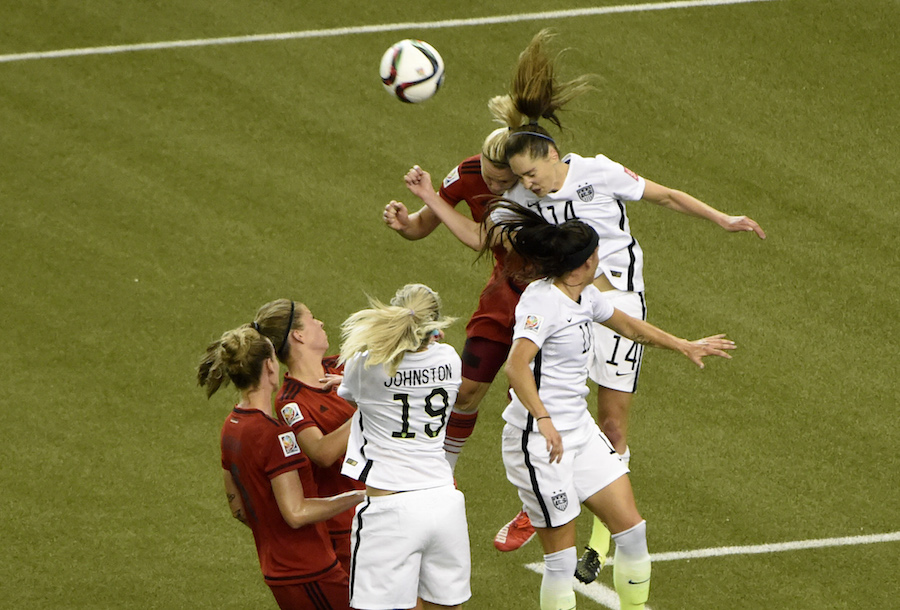This article originally appeared in Mile High Sports Magazine. Read the full digital edition.
It’s doubtful we’ll ever see a major motion picture on the subject, but for what it’s worth, those parents worried about having their kids play football might want to reconsider the whole soccer thing as well.
There are factions of society who want to get rid of football due to the hysteria surrounding concussions. There are parents who won’t let their kids play America’s favorite sport but are okay with them playing “the world’s” favorite sport because, well, it’s not as violent and thereby less damaging, right?
It’s certainly true that soccer does not have the violent collisions “built in” as part of every single play of every single game. But does that mean kids are safer playing soccer than football? Not necessarily.
A study published last summer by JAMA Pediatrics suggests that concussions are “a major issue in youth soccer.” Like football, there was a lawsuit filed in August 2014 by a group of parents in United States District Court in California charging FIFA, U.S. Soccer and the American Youth Soccer Organization with failing to do enough to prevent head injuries (as if FIFA needed another headache, pardon the pun). The lawsuit and release of the JAMA study caused the U. S. Soccer Federation to institute a ban on “headers” in youth games for children age 11 and under. The ban on headers was enough to settle the lawsuit, even though it’s not all-inclusive. According to an article on Deadspin, “The new rules do not apply to all youth soccer players in America, only those that play on teams under the auspices of U.S. Soccer, which includes all youth national teams and academies, including Major League Soccer youth club teams.”
Plus, the ban on headers for smaller children also doesn’t address the fact that high school kids are also damaging themselves with headers and just as often via direct “head to head” contact and head contact with the playing surface. That last part sounds pretty familiar to football fans. And while football at the high school, college and professional levels monitors concussions and requires players suspected of having a head injury be removed from the game, soccer has no such policy. Furthermore, substitution limitations actually discourage players from coming out of the game if they don’t absolutely have to.
Here’s the rub: Football can and is doing something about their concussion problem. They’ve already legislated the helmet out of the tackling equation and put medical procedures in place to help keep players safer. More importantly, football helmets are being improved daily – everything from Kevlar to foam insulation is being tried to make the design of football helmets even more protective.
But what can soccer do? The art of heading the ball is an integral part of the game. Eliminating headers at higher levels? Running at full speed while trying to get the ball or keep the ball away from your opponent is also pretty important. Under those circumstances, collisions will happen. If they try to legislate collisions completely out of soccer the game would drag even more.
Soccer has no equipment they can improve without dramatically altering how the game has been played for decades. Can anyone see soccer players wearing helmets and/or pads like football players?
So what’s soccer going to do and when does the movie about it come out?
***
In Response to Mark: The issue of concussions in soccer is a very real one, and one that needs to be addressed. Would helmets looks silly in soccer? The short answer is yes, but like many wise adults have cautioned to children over the years, it’s better to be safe than ‘look cool.’
Then again, maybe it just takes the game’s greatest athletes to set an example. Think of Rip Hamilton tearing up the NBA while wearing the facemask. It’s already happened in soccer. Since suffering a depressed skull fracture in 2006, longtime Chelsea turned Arsenal goalkeeper Petr Čech has worn a rugby style head guard. He may look like Toad from the Super Mario series, but no one is batting an eye; Čech continues to be one of the best goalkeepers in the Premier League.
Helmets aren’t the only answer; some legislation is required. On the local level, Colorado Governor John Hickenlooper enacted the Jake Snakenburg Youth Concussion Act in 2012. The Colorado law requires coaches to recognize the symptoms of head trauma and, as a result, more and more teams are following a ‘return to play protocol.’ According to researchers from Children’s Hospital, the result has been a measurable decrease in second impact syndrome, or dramatic brain swelling suffered shortly after the initial injury.
Yet, regardless of these recent steps, CTE remains as real in soccer as it is in the NFL. Bellini, a Brazilian soccer star who played alongside Pelé, was posthumously diagnosed with the condition in 2014. But the sport’s governing body, FIFA, is currently dealing with a laundry list of major issues including bribery, corruption, and human rights violations.
Don’t expect a movie to come out any time soon. {Marco Cummings, MLSsoccer.com}
